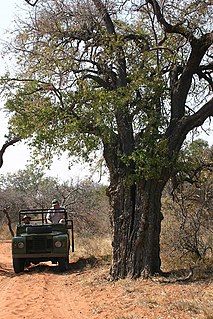
Spirostachys is a plant genus of the family Euphorbiaceae first described as a genus in 1850. It is native to Africa. Zuloaga, F. O., O. Morrone, M. J. Belgrano, C. Marticorena & E. Marchesi. (eds.) 2008. Catálogo de las plantas vasculares del Cono Sur. Monographs in systematic botany from the Missouri Botanical Garden 107(1–3): i–xcvi, 1–3348.
Hickelia is a genus of African bamboo in the grass family.
- Hickelia africanaS.Dransf. - Tanzania
- Hickelia alaotrensisA.Camus - Madagascar
- Hickelia madagascariensisA.Camus - Madagascar
- Hickelia perrieri(A.Camus) S.Dransf. - Madagascar

Nepenthes madagascariensis is one of two Nepenthes pitcher plant species native to Madagascar, the other being N. masoalensis.
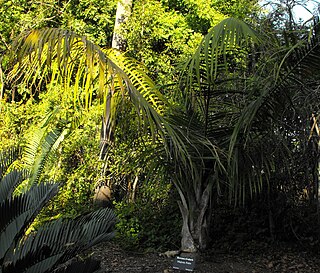
Ravenea is a genus of 20 known species of palms, all native to Madagascar and the Comoros.

Ulmus castaneifoliaHemsley, the chestnut-leafed elm or multinerved elm, is a small deciduous tree found across much of China in broadleaved forests at elevations of 500–1,600 metres (1,600–5,200 ft).
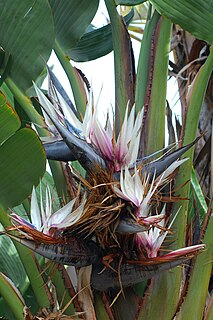
Strelitzia nicolai, commonly known as the wild banana or giant white bird of paradise, is a species of banana-like plants with erect woody stems reaching a height of 7–8 m (23–26 ft), and the clumps formed can spread as far as 3.5 m (11 ft).
Xanthocercis madagascariensis is a species of flowering plant in the family Fabaceae. It is found only in Madagascar.
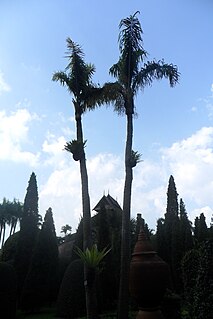
Dypsis madagascariensis is a species of flowering plant in the family Arecaceae. It is found only in Madagascar. It is threatened by habitat loss.
Masoala is a genus of flowering plant in the family Arecaceae. It contains the following species, both endemic to Madagascar:
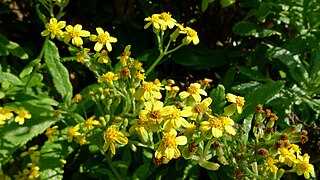
Senecio madagascariensis, also known as Madagascar ragwort, is a species of the genus Senecio and family Asteraceae that is native to Southern Africa. Other common names include Madagascar groundsel and fireweed. It has been included on the noxious weeds list for Hawaii and the reject list for Australia. S.madagascariensis is the diploid cytotype of S.inaequidens.
Yvesia is a genus of plants in the grass family. The only known species is Yvesia madagascariensis, found only in Madagascar.
Petchia madagascariensis is a plant in the family Apocynaceae.
Decaryella is a genus of plants in the grass family. The only known species is Decaryella madagascariensis, native to Madagascar.

Brexia is a plant genus assigned to the Celastraceae. It is a dense evergreen shrub or small tree of usually around 5 m high, with alternately set, simple, leathery leaves with a short leaf stem and lanceolate to inverted egg-shaped leaf blades. The pentamerous flowers occur in cymes. The petals are greenish white, the samens are alternating with wide, incised staminodes. The superior ovary develops in a long ribbed fruit. Brexia naturally grows on the coast of East Africa, on Madagascar, the Comoros and Seychelles. Opinions differ about the number of species in Brexia. Sometimes the genus is regarded monotypic, B. madagascariensis being a species with a large variability, but other authors distinguish as many as twelve species. Common names for B. madagascariensis include jobiapototra, tsimiranjana, tsivavena, vahilava, voalava, voankatanana, voantalanina, voatalanina and votalanina, and mfukufuku (Swahili), mfurugudu and bwa kato (Seychelles).
Abrus madagascariensis is a plant in the legume family Fabaceae, native to Madagascar. It grows as a herb, shrub or liana.

Plectranthus madagascariensis, called thicket coleus, Madagascar coleus and candle plant, is a species of flowering plant in the family Lamiaceae. It is native to South Africa, eSwatini, Mozambique, Mauritius and Réunion, but not Madagascar. Its cultivar 'Variegated Mintleaf' has gained the Royal Horticultural Society's Award of Garden Merit.

Humbertia is a monotypic genus of flowering plants belonging to the family Convolvulaceae. It only contains one species, Humbertia madagascariensisLam. It is native to Madagascar.
Helmiopsiella is a genus of flowering plants belonging to the family Malvaceae.
Pilgerina is a monotypic genus of flowering plants belonging to the family Santalaceae. It only contains one known species, Pilgerina madagascariensisZ.S.Rogers, Nickrent & Malécot
Koehneria is a monotypic genus of flowering plants belonging to the family Lythraceae. The only species is Koehneria madagascariensis(Baker) S.A.Graham, Tobe & Baas









